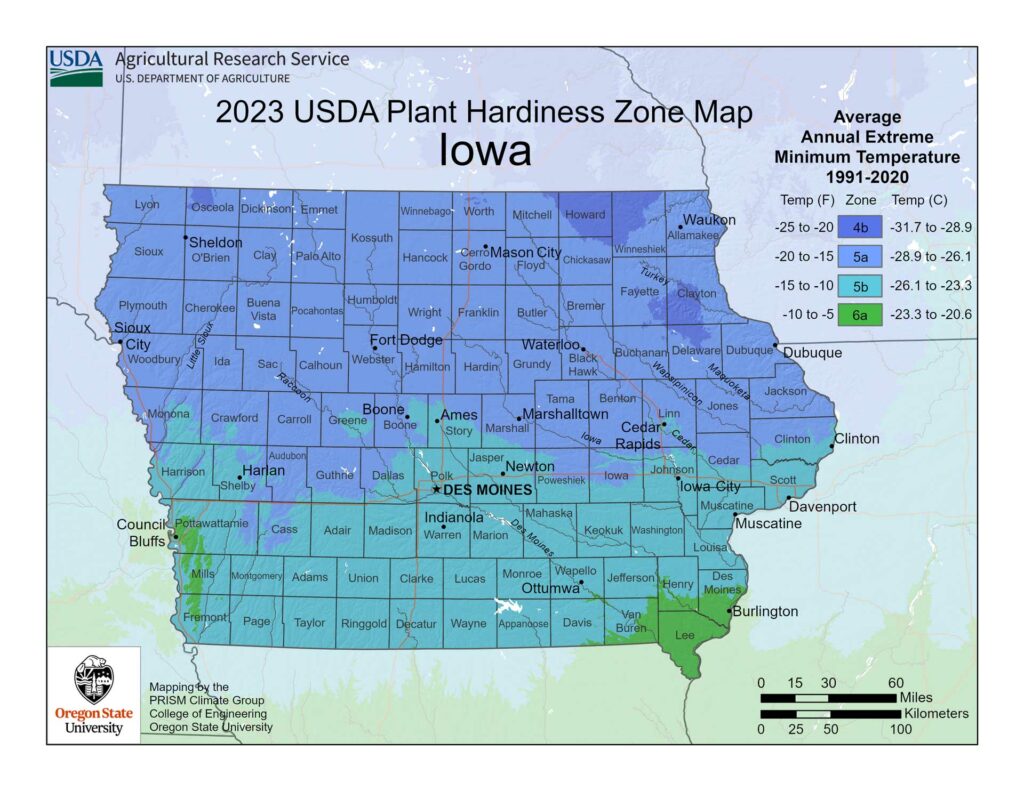The USDA updated the Climatic Zone Charts for the United States last autumn. In Spencer, Iowa; Spirit Lake, Iowa and Stom Lake, Iowa we had been classified Zone 4A. A Zone 4 winter was one in which the low temperatures were between -20 and -30 without the windchill factor. The Climate Zone was also split into the northern part as Climate Zone 4A, with winter lows of -25 to -30. It seems that this area drops to minus -20 or colder temperature almost every year. So, should we not plant shrubs, trees and perennials that are listed as Zone 5 in Estherville, Whapeton and Okoboji?
At Del’s Garden Center, we rely on growers like Bailey Nursery of St. Paul, Minnesota to give us great advice. We consult with growers like J. Frank Schmidt in Oregon and Monrovia Growers to give us good advice. I like to visit trial gardens like McCrory Gardens in Brookings, South Dakota, the Minnesota Landscape Arboretum, the Iowa Arboretum, Reiman Gardens and trial gardens at Bailey Nursery in St. Paul, Minnesota. Proven Winners plants are trialed all over the country so good information about these plants comes from the Northeast United States as well. At Del’s Garden Center we wish to have the best and hardiest plants for those who live in Hartley, Iowa or Algona, Iowa.
In the past we sold a lot of Hybrid Tea Roses at Del’s. These beautiful plants are solidly Zone 6. The use of Rose Cones, Rose Collars and elaborate wooden boxes with removable lids were used to successfully get Hybrid Tea Roses to winter in Northwest Iowa. There are many shrubs listed as Zone 5 that do well in Spirit Lake and Storm Lake. There are many more shrubs listed as Zone 5 that don’t do so well in Emmetsburg and Spencer. In the past we had a K-Mart in Spencer and interestingly, the nursery buyers for the K-Marts in this area were based in Kansas City. Our local store had all kinds of Zone 5 and Zone 6 plants shipped into the local stores. The sad thing about this southern buying situation was that homeowners who were planning to make their home and landscape look beautiful, might not have had the success that they had hoped for. Every now and then I would come across a Zone 5 Azalea or Pieris that seemed to be doing fine in Spencer. There was a beautiful Weeping Cherry on East 9 th Street in Spencer that I admired for years that should not have survived this far north.
Climate zone maps are useful for trees and shrubs which have much of their tissue above ground. But perennial flowers and ornamental grasses die down to their roots, bulbs, rhizomes or other structures under the ground. When we experience an open winter like we experienced this winter of 2023-2024, some perennials don’t do so well. There could be losses to plants like Dianthus, Daisies, Garden Mums and more. Even Minneapolis had quite an open winter! Normally Minnesotans in the Minneapolis area get around 40 to 48 inches of snow which insulates perennials quite well. Sometimes perennials that don’t winter so well in this area do great in the Minneapolis area due to the snow cover.
There are many factors that affect plant hardiness. Cold winter temperatures are only part of the equation. Even though this winter has been very warm, our low winter temperatures did drop to -18 to -20. Every few years we get as cold as -25 and -30. With the new Climate Zone maps, exactly what zone are we now? Have our winters been slowly getting warmer? Look at the maps below provided by Iowa State University Extension. Clearly the maps show that Iowa appears to be having warmer winters with fewer extreme low temperatures that damage plants. Will all sorts of new Azaleas live in Sheldon and Arnolds Park now that they are in Zone 5? Will all Zone 5 trees and shrubs now live in West Okoboji and West Bend?


“Nearly all of Iowa is now in Zone 5, with the northern half in 5a and the southern half in 5b. Small areas in northeast Iowa remain in Zone 4b, and small areas in southeast and southwest Iowa are now in Zone 6a. The data on which the 2023 map is based was gathered from 1991 to 2020.Dec 12, 2023 Iowa State University Extension My dad Del could not have imagined that one day his business would ever sell Azaleas or Big Leaf Hydrangea. Due to plant breeding by the University of Minnesota; growers like Bailey Nursery and Monrovia Growers, now offer very hardy versions of plants that did not survive our winters in Northwest Iowa and Southwest Minnesota. Proven Winners is trialing plants all over the country for winter hardiness. North Dakota State University and Iowa State University have been breeding and finding more winter hardy selections of trees and shrubs.
The new climate zone maps need to be understood in a different way. These maps are guidelines as to what plants will likely do well in different parts of the State of Iowa. Look at the zone maps as if they were crop insurance. Some gardeners like to take some risks and enjoy the rewards of growing a plant that might be a little tender. After all, Hybrid Tea Roses are still grown in Northwest Iowa. Others might wish to only plant Zone 3 and Zone 4 plants to limit the possibility of problems down the road. Remember that these climate zone maps don’t show issues that plants may have with drought, flooding, insects and diseases!
So how do I know what Zone 5 plants will live in Spencer or Spirit Lake? The answer is to depend on the expert horticultural experience you can find at Del’s Garden Center. We have the confidence to offer great perennial flowers that might have a label that lists the plant as Zone 5. We have been offering some trees that one grower might list as Zone 5 and another grower might list as Zone 4. My co-horts and I visit trial gardens and arboretums to see how well plants perform. Our landscape department uses the most reliable and resilient plants in their designs, reducing the number of plants our crews need to replace.
If only Crape Myrtle trees grew this far north…
– Todd Brockshus, Senior Horticulturalist
